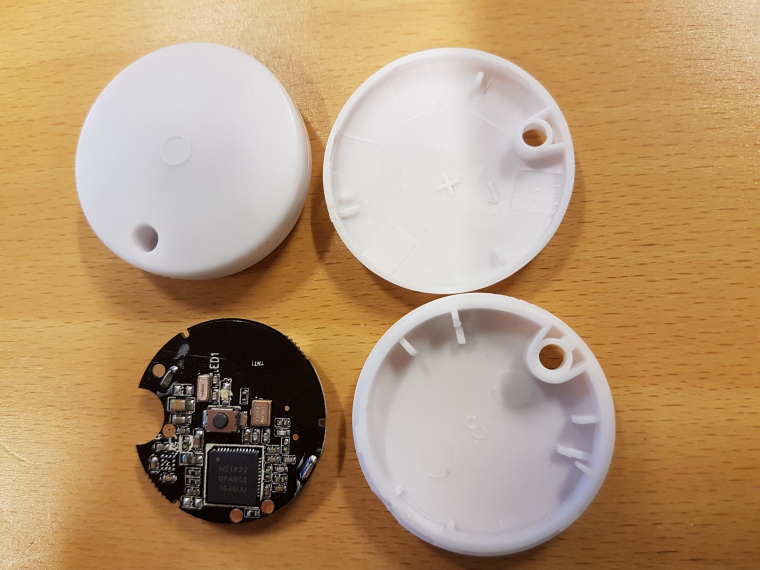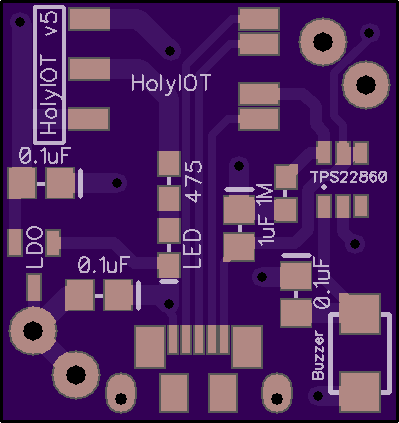nRF5 action!
-
Just received these tiny NRF51822 devices and would like to turn them in to MySensors 1 button scencontroller.
Where should I start?- I guess I will need some kind of USB adapter ti program them. Think I read somewhere about JLink. Would this do?

-
Just received these tiny NRF51822 devices and would like to turn them in to MySensors 1 button scencontroller.
Where should I start?- I guess I will need some kind of USB adapter ti program them. Think I read somewhere about JLink. Would this do?

@korttoma did you check here ?
https://forum.mysensors.org/topic/6705/mysensors-nrf5-platformFor programming the best solution is probably the NRF52 DK, it's not very expensive (30€) and you avoid all the problems related to license of the fake JLINKs (and bricking of the device if you happen to accept the invitation to update the outdated firmware on it), as it includes official licence for programming all nrf5 chips.
https://www.arrow.com/en/products/nrf52-dk/nordic-semiconductor -
Hi,
Working without problem with mysensors, I use STLink v2 from Aliexpress. LED and Button are mapped on pins 28 and 29 :)
@mika :+1:
Now I feel stupid ordering the NRF52 DK for 28€. Well atleast I don't need to worry about bricking any devices.
Do you have an example sketch for the device you can share?
Is it possible to somehow monitor the battery status? -
@mika :+1:
Now I feel stupid ordering the NRF52 DK for 28€. Well atleast I don't need to worry about bricking any devices.
Do you have an example sketch for the device you can share?
Is it possible to somehow monitor the battery status?@korttoma said in nRF5 Bluetooth action!:
Is it possible to somehow monitor the battery status?
One of @d00616 's demo sketches allows you to read the voltage that's powering the nRF5. Assuming there is no booster involved on this device (seems unlikely), that would be the same as the battery voltage.
-
Just received these tiny NRF51822 devices and would like to turn them in to MySensors 1 button scencontroller.
Where should I start?- I guess I will need some kind of USB adapter ti program them. Think I read somewhere about JLink. Would this do?

-
It would probably do well as a "one button scene controller," but is it good for anything else I wonder?
-
It would probably do well as a "one button scene controller," but is it good for anything else I wonder?
-
I was tempted to try adding the missing accelerometer too, but in the end it's easier and cheaper to make a board with the 2$ module.
-
Speaking of which, I shrunk the HolyIOT board a bit and added the small buzzer:

Hopefully this is small enough that it can be used as a locator beacon.It turns out this is pretty nearly the minimum size, even if the HolyIOT were smaller, because of the CR2032 battery underneath it. Anyway, that's an interesting result, because the BC182 is smaller than the HolyIOT, but I wouldn't get the benefit of it.
-
Speaking of which, I shrunk the HolyIOT board a bit and added the small buzzer:

Hopefully this is small enough that it can be used as a locator beacon.It turns out this is pretty nearly the minimum size, even if the HolyIOT were smaller, because of the CR2032 battery underneath it. Anyway, that's an interesting result, because the BC182 is smaller than the HolyIOT, but I wouldn't get the benefit of it.
@neverdie said in nRF5 Bluetooth action!:
small buzzer:
CR2032 batteryIf I'm not wrong this buzzer needs over 100mA, not sure it's a good match for a CR2032 ?
-
Hi,
Working without problem with mysensors, I use STLink v2 from Aliexpress. LED and Button are mapped on pins 28 and 29 :)
@mika said in nRF5 Bluetooth action!:
Hi,
Working without problem with mysensors, I use STLink v2 from Aliexpress. LED and Button are mapped on pins 28 and 29 :)
Im just reporting sketch from NeverDie ;)
https://www.openhardware.io/view/510/Multi-Sensor-TempHumidityPIR-LeakMagnetLightAccel
-
@neverdie said in nRF5 Bluetooth action!:
small buzzer:
CR2032 batteryIf I'm not wrong this buzzer needs over 100mA, not sure it's a good match for a CR2032 ?
@nca78 said in nRF5 Bluetooth action!:
@neverdie said in nRF5 Bluetooth action!:
small buzzer:
CR2032 batteryIf I'm not wrong this buzzer needs over 100mA, not sure it's a good match for a CR2032 ?
I like how nothing slips past you! Yes, it's a pretty severe trade-off in exchange for its small size. So, I'll be using two CR2032's and make it run only in very short bursts. I honestly don't know how well or badly it will turn out.
-
@nca78 said in nRF5 Bluetooth action!:
@neverdie said in nRF5 Bluetooth action!:
small buzzer:
CR2032 batteryIf I'm not wrong this buzzer needs over 100mA, not sure it's a good match for a CR2032 ?
I like how nothing slips past you! Yes, it's a pretty severe trade-off in exchange for its small size. So, I'll be using two CR2032's and make it run only in very short bursts. I honestly don't know how well or badly it will turn out.
@neverdie said in nRF5 Bluetooth action!:
I like how nothing slips past you! Yes, it's a pretty severe trade-off in exchange for its small size. So, I'll be using two CR2032's and make it run only in very short bursts. I honestly don't know how well or badly it will turn out.
I don't see anything to co trim such a high current on your board ? Maybe it's the reason the sound level is low on your other board, max current of the MCU pin is much lower than what the buzzer needs ?
-
@neverdie said in nRF5 Bluetooth action!:
I like how nothing slips past you! Yes, it's a pretty severe trade-off in exchange for its small size. So, I'll be using two CR2032's and make it run only in very short bursts. I honestly don't know how well or badly it will turn out.
I don't see anything to co trim such a high current on your board ? Maybe it's the reason the sound level is low on your other board, max current of the MCU pin is much lower than what the buzzer needs ?
@nca78 said in nRF5 Bluetooth action!:
@neverdie said in nRF5 Bluetooth action!:
I like how nothing slips past you! Yes, it's a pretty severe trade-off in exchange for its small size. So, I'll be using two CR2032's and make it run only in very short bursts. I honestly don't know how well or badly it will turn out.
I don't see anything to co trim such a high current on your board ? Maybe it's the reason the sound level is low on your other board, max current of the MCU pin is much lower than what the buzzer needs ?
What does "co trim" mean?
-
@nca78 said in nRF5 Bluetooth action!:
@neverdie said in nRF5 Bluetooth action!:
I like how nothing slips past you! Yes, it's a pretty severe trade-off in exchange for its small size. So, I'll be using two CR2032's and make it run only in very short bursts. I honestly don't know how well or badly it will turn out.
I don't see anything to co trim such a high current on your board ? Maybe it's the reason the sound level is low on your other board, max current of the MCU pin is much lower than what the buzzer needs ?
What does "co trim" mean?
@neverdie said in nRF5 Bluetooth action!:
What does "co trim" mean?
Sorry phone rewriting what I type.
"Control".
MCU pins can't source that much current and I see no transistor on your board to do it ?
If you put a reserve capacitor big enough to supply 100+mA long enough to make some sound on the buzzer, will you not fry the pin ? -
@neverdie said in nRF5 Bluetooth action!:
What does "co trim" mean?
Sorry phone rewriting what I type.
"Control".
MCU pins can't source that much current and I see no transistor on your board to do it ?
If you put a reserve capacitor big enough to supply 100+mA long enough to make some sound on the buzzer, will you not fry the pin ?The present design uses a TPS22860 load switch to turn on and off the buzzer. I'm not trying to power the buzzer directly from one of the nRF52832 pins, because the current would be outside the maximum limits for the nRF52832 pin. I'm hoping the two CR2032's will give enough headroom that the voltage (after the LDO) will be stable.
